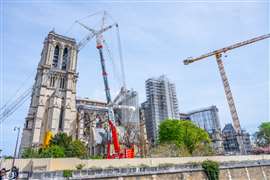Four charts that show the state of construction in Europe
23 November 2023
 Construction work to repair Notre-Dame Cathedral in Paris after a 2019 blaze (Image: pyty via AdobeStock - stock.adobe.com)
Construction work to repair Notre-Dame Cathedral in Paris after a 2019 blaze (Image: pyty via AdobeStock - stock.adobe.com)
Sharply declining confidence within the construction industry in some of Europe’s biggest economies this year has dragged down sentiment across the region overall.
That’s what one of a series of charts compiled by the Construction Briefing from official European figures shows.
The four charts offer a snapshot of the state of the construction sector in Europe.
Europe’s largest economy Germany is in the grip of a property crisis and construction confidence, already waning in the spring, has taken a sharper downward trajectory from the summer onwards, one chart shows.
Confidence now sits at -18.1 on Eurostat’s construction confidence indicator, the lowest level of Europe’s five biggest economies.
While at a higher level than Germany and the EU-27 nations overall, confidence also dipped in France in October 2023, to a score of -6.3.
But other nations like the Netherlands, Spain and Italy paint a slightly brighter picture, all of them seeing increases in construction confidence last month and remaining in positive territory.
Construction production volume still remains just above pre-covid levels in the EU-27 countries as a whole, according to the second of our charts.
In France, it is roughly in line with pre-covid levels, whereas in Germany, production has declined slightly from a score of 119.2 in January 2020 (on an index where 2015=100), down to 110.9 in October 2023.
Italy and the Netherlands still saw higher construction production at higher volumes last month than before the pandemic, although production in the Netherlands has started to decline gradually since the spring of this year.
Looking at the EU construction producer price index, which measures the prices of construction activities in new residential buildings from the point of view of the building constructor, illustrates why the residential construction market has become much tougher this year.
Costs have been on a steady and steep upward trajectory since 2021 and only started to moderate towards the end of 2022. As a result, producer prices have also risen sharply.
And the number of construction companies declaring themselves bankrupt across Europe has risen steadily in 2023 but has so far stayed below the pre-covid peak.
Although bankruptcies are a lagging indicator, the rise reflected the effects of post-covid supply chain problems, Russia’s invasion of Ukraine, and price rises.
The index hit 91.8 in the first quarter of 2023, rising to 97.5 in Q2 2023, and remaining flat in Q3 at 97.6.
That is still some way below the pre-covid Q3 2019 peak of 111.7, however.
Bankruptcy registrations fell to their lowest level since 2015 in Q2 of 2020, as countries suspended the obligation to file for bankruptcy for part of the year and financial support measures to support businesses affected by a wave of Covid-19 lockdowns across the world put struggling companies into stasis.
But as Europe emerged from the pandemic, so bankruptcies started to rise once again. The increase was particularly marked in the third quarter of 2022, when the index hit 90.8, up from 84.1 in the same period a year before.
STAY CONNECTED



Receive the information you need when you need it through our world-leading magazines, newsletters and daily briefings.
CONNECT WITH THE TEAM








